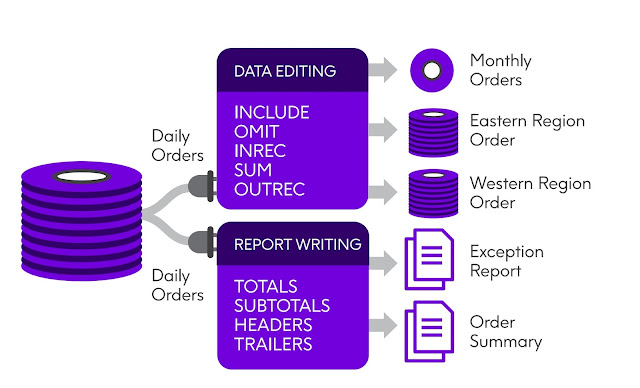.jpg) |
| Syncsort MFX. |
Mainframe systems have a plethora of powerful tools and utilities that help organizations to streamline their operations and achieve maximum efficiency. One such tool is the MFX Syncsort Utility.
In this article, we will deep dive into the world of MFX Syncsort and explore what it is, its functions such as sorting and merging, and how organizations can utilize it to enhance their data management processes. So without wasting any time let's get started with Mainframe Syncsort.
Introduction to the MFX Syncsort Utility.
IBM Mainframes are known for their computing capacity and they process millions of transactions every day for various organizations. Mainframes are the backbone of business computing. In order to manage and perform various data manipulation operations on such a huge volume of data, you need a certain set of tools/utilities, or software.
Mainframe Syncsort MFX is a high-performance sorting, copying, and merging utility. Synsort MFX exploits the advanced capabilities of the z/OS operating system and IBM® Z mainframes. Precisely's Syncsort MFX is the most popular third-party software product among IBM and compatible mainframes. It's widely used in almost 85 countries and it has a proven track record of 45+ years.
What is Syncsort MFX (Mainframe Synsort)?
SYNCSORT MFX is a data manipulation utility that is predominantly used on IBM Mainframe for sorting, merging, and copying data files. This efficient and versatile tool is capable of handling large volumes of data, without any performance issues. The former name of Syncsort MFX was MFX for z/OS. Synscort MFX is used for a wide range of used cases. The SYNCOSRT MFX utility is invoked via JCL on the IBM Mainframe.
Basic Functions of Syncsort MFX utility.
The SYNCSORT MFX utility is an essential tool for sorting, merging, or copying large data files. However, It can also eliminate duplicates and reformat data into specific formats, making it suitable for a wide variety of applications.
For example, Syncsort MFX utility can sort customer transactions, streamline account reconciliation, generate monthly or ad-hoc reports, reformat data, and detect fraudulent activities.
The following figure illustrates the application of the Mainframe utility (SYNCSORT MFX).
 |
| Mainframe Syncsort MFX. |
MFX’s Data Utility and SortWriter Features.
MFX aims to enhance the efficiency of programmers by cutting down the amount of time spent on developing, testing, and fixing applications. With its robust Data Utility and SortWriter functionalities, complex data processing tasks that once needed several steps to complete can now be achieved with just one execution.
The Data Utility features of MFX comprise of a join function, multi-output capability, extensive report generation options, and the ability to create output files in PDF, RTF, or HTML format, and send them to multiple recipients via email. It also offers various record selection and record formatting options, providing you with the means to design sort, merge, and copy applications that can handle a wide range of related activities.
Example of SYNCSORT MFX utility.
Here is an example of an Outstanding Payments report, the packed-decimal Amount Due
field on a company’s invoice records are converted to printable format and edited
with a floating dollar sign, commas, and a decimal point. In addition, to make the
output easy to read, ten blanks are inserted between the Company Name field and
the Amount Due field.
//SORTJOB JOB (acctinfo),'Sort Job',CLASS=A,
// MSGLEVEL=(1,1)
//*
// EXEC PGM=SYNCSORT Identifies the Program
//SYSOUT DD SYSOUT=* Assigns MFX Messages
//* to I/O Device
//SORTIN DD DSN=INVOICE,DISP=SHR Defines Input Data Set
//SORTOUT DD SYSOUT=* Defines Output Data Set
//SORTWK01 DD SPACE=(CYL,5),UNIT=SYSDA Defines Intermediate Storage
//SYSIN DD *
SORT FIELDS=(1,23,CH,A) Sorts Records
OUTREC FIELDS=(1,23, Converts and Edits Data
10X, and Inserts Blanks
24,4,PD,EDIT=($II,IIT.TT))
//*
Maximizing the Potential of SYNCSORT MFX.
How Syncsort Works.
To fully utilize the Syncsort utility, it's essential to have a basic understanding of how it operates. Mainframe Syncsort utility works in two phases: the input phase and the output phase. During the input phase, the command reads the data file and prepares it for sorting, merging, etc. During the output phase, the sorted data is written to a new file.
Customizing the Sorting Process with Syncsort Options.
The Syncsort Command has several options that can be used to tailor the sorting process to your specific needs. For example, you can set the sort order (ascending or descending), the sort key (the field or fields used to sort the data), and the output format (the format of the new file).
Efficiency and Scalability with Syncsort.
One of the main benefits of Syncsort's utility is its ability to handle large amounts of data. This makes it ideal for organizations that process significant amounts of data, such as banks and healthcare providers. With the Syncsort Command, you can sort and merge data files in just a matter of minutes, saving time and resources.
Conclusion
In conclusion, Syncsort MFX is a versatile and efficient tool for sorting and merging large data files. Whether you work in finance, healthcare, or any other industry that deals with large volumes of data, the Syncsort Command can help streamline operations and increase productivity. With a solid understanding of how it works and its various options, you can fully leverage the power of the Syncsort Command to optimize your processes.
►Subscribe to Topictrick & Don't forget to press THE BELL ICON to never miss any updates. Also, Please visit mention the link below to stay connected with Topictrick and the Mainframe forum on -
► Youtube
► Facebook
► Linkedin
► Reddit
Thank you for your support.
Mainframe Forum™
No comments:
Post a Comment